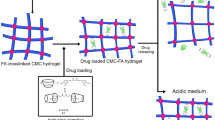Abstract
A new amphiphilic hyperbranched poly (amine-ester)-poly(ε-caprolactone) copolymer (HPAE-co-PCL) was synthesized by ring-opening polymerization of ε-caprolactone and branched poly (amine-ester) (HPAE-OHs) with Sn(Oct)2 as catalyst. The chemical structures of copolymers were determined by FT-IR, 1H-NMR (13C-NMR), thermo gravimetric analysis apparatus (TGA) and differential scanning calorimetry (DSC). Camptothecin (CPT)-loaded copolymer nanoparticles were prepared by the oil-in water (o/w) emulsion technique method. Their physicochemical characteristics, e.g. morphology and nanoparticles size distribution were then evaluated by means of fluorescence spectroscopy, environmental scanning electron microscopy (ESEM), and dynamic light scattering (DLS). CPT-loaded nanoparticles assumed a spherical shape and have unimodal size distribution. It was found that the chemical composition of the nanoparticles was a key factor in controlling nanoparticles size, drug-loading content, and drug release behavior. As the molar ratio of ε-caprolactone to HPAE increased, the nanoparticles size and drug-loading content increased, and the drug release rate decreased. The antitumor activity of the CPT-loaded HPAE-co-PCL nanoparticles against human hepatoma HEPG2 cells was evaluated by 3-(4, 5-Dimethylthiazol-2-yl)-2,5-diphenyl tetrazolium bromide (MTT) method. The CPT-loaded HPAE-co-PCL nanoparticles showed comparable anticancer efficacy with the free drug.










Similar content being viewed by others
References
Riess G (2003) Prog Polym Sci 28:1107
Lei LC, Gohy JF, Willet N, Zhang JX, Varshney S, Jerome R (2006) Polymer 47:2723
Lo CL, Huang CK, Lin KM, Hsiue GH (2007) Biomaterials 28:1225
Han HD, Shin BC, Choi HS (2006) Eur J Pharm Biopharm 62:110
Yoo HS, Park TG (2001) J Control Rel 70:63
Hans M, Shimoni K, Danino D, Siegel SJ, Lowman A (2005) Biomacromolecules 6:2708
Lin R, Ng LS, Wang CH (2005) Biomaterials 26:4476
Wang CH, Wang CH, Hsiue GH (2005) J Control Rel 108:140
Agrawal SK, Sanabria-DeLong N, Coburn JM, Tew GN, Bhatia SR (2006) J Control Rel 112:64
Jiang XZ, Zhang JY, Zhou YM, Xu J, Liu SY (2008) J Polym Sci Part A: Polym Chem 46:860
Zhu ZS, Li Y, Li XL, Li RT, Jia ZJ, Liu BR, Guo WH (2010) J Control Rel 142:438
Zhang WL, Li YL, Liu LX, Sun QQ, Shuai XT, ZHU W, Chen YM (2010) Biomacromolecules 11:1331
Duan KR, Chen HL, Huang J, Yu JH, Liu SY, Wang DX, Li YP (2010) Carbohydrate Polymers 80:498
Torchilin VP (2001) J Control Rel 73:137
Layre A, Couvreur P, Chacun H, Richard J, Passirani C, Requier D, Benoit JP, Gref R (2006) J Control Rel 111:271
Savic R, Luo L, Eisenberg A, Maysinger D (2003) Science 300:615
Li YY, Zhang XZ, Kim GC, Cheng H, Cheng SX, Zhuo RX (2006) Small 2:917
Gao C, Yan D (2004) Prog Polym Sci 29:183
Bikiaris DN, Karayannidis GP (2003) Polym Int 52:1230
Tian HY, Deng C, Lin H, Sun JR, Deng MX, Chen XS, Jing XB (2005) Biomaterials 26:4209
Rajesh KK, Muthiah G, Munia G, Tanay G, Donald EB, Souvik M, Jayachandran NK (2006) Biomaterials 27:5377
Karger-Kocsis J, Frohlich J, Gryshchuk O, Kautz H, Frey H, Mulhaupt R (2004) Polymer 45:1185
Gao C, Xu YM, Yan DY, Chen W (2003) Biomacromolecules 4:704
Kolhe P, Misra E, Kannan RM, Kannan S, Lieh-Lai M (2003) Int J Pharm 259:143
Hyun JK, Min SK, Joon SC, Bo HK, Jae KY, Kwan K, Jong-sang P (2007) Bioorgan & Med Chem 15:1708
Garcia-Carbonero R, Supko JG (2002) Clin Cancer Res 8:641
Hatefi A, Amsden B (2002) Pharm Res 19:1389
Bogdanov B, Vidts A, Van Den Bulcke A, Verbeeck R, Schacht E (1998) Polymer 39:1631
Zhu BK, Wei XZ, Xiao L, Xu YY, Geckeler KE (2006) Polymer International 55:63
Govender T, Stolnik S, Garnett MC, Illum L, Davis SS (1999) J Control Rel 57:171
Jeong YI, Cheon JB, Kim SH, Nah JW, Lee YM, Sung YK, Akaike T, Cho CS (1998) Rel 51:169
Lu Y, Lin D, Wei HY, Shi WF (2000) Acta Polymerica Sinica 4:411
Karayannidis GP, Roupakias CP, Bikiaris DN, Achilias DS (2003) Polymer 44:931
Zhang LM (2001) Carbohydrate Polymers 45:1
Choi KC, Bang JY, Kim PI, Kim C, Song CE (2008) Int J Pharm 355:224
Niwa T, Takeuchi H, Hino T, Kunou N, Kawashima Y (1993) J Control Rel 25:89
Acknowledgments
Project supported by the major program for fundamental research of the Chinese academy of sciences, China (No: KJCX2-YW-M02); the State Key Development Program for Basic Research of China (973) (No: 2009CB930200;2010CB934004), (863) (No: 2007AA02Z150; 2006AA03Z321).
Author information
Authors and Affiliations
Corresponding author
Rights and permissions
About this article
Cite this article
Wu, Y., Wang, T., Li, M. et al. Hyperbranched poly (amine-ester)-poly(ε-caprolactone) copolymer and their nanoparticles as camptothecin delivery system. J Polym Res 18, 1147–1158 (2011). https://doi.org/10.1007/s10965-010-9518-x
Received:
Accepted:
Published:
Issue Date:
DOI: https://doi.org/10.1007/s10965-010-9518-x




